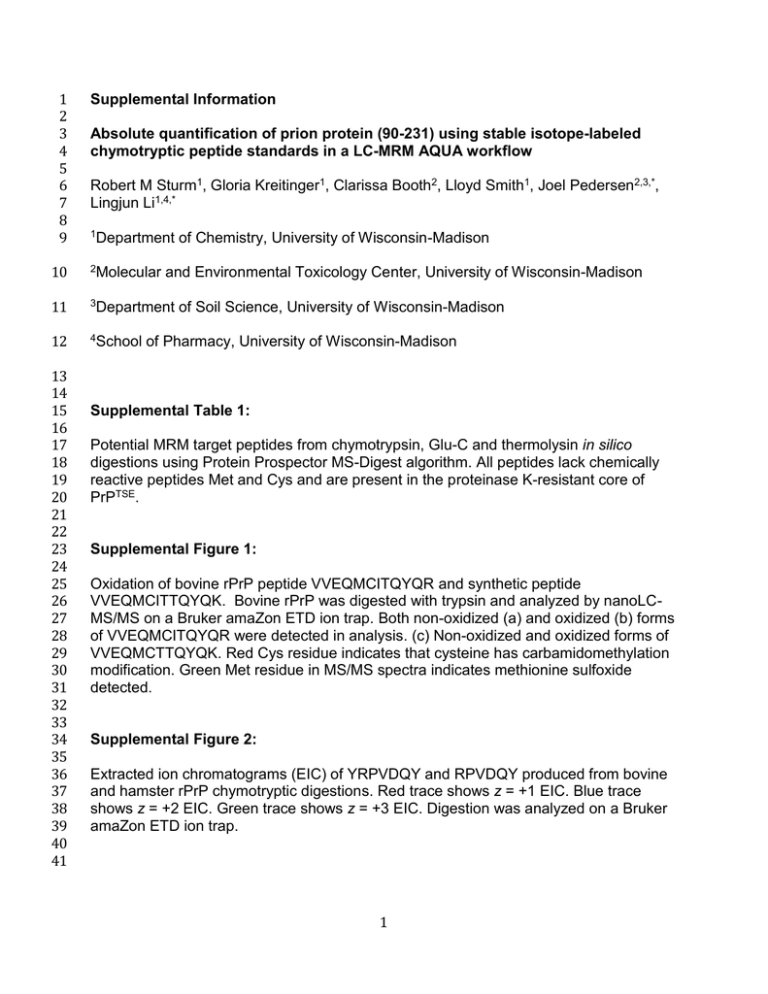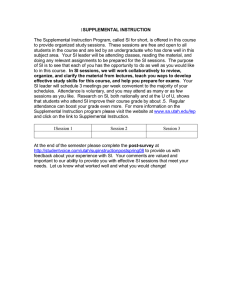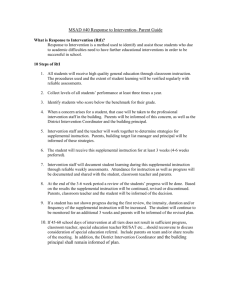1 2 3 Supplemental Information
advertisement

1 2 3 4 5 6 7 8 9 Supplemental Information Absolute quantification of prion protein (90-231) using stable isotope-labeled chymotryptic peptide standards in a LC-MRM AQUA workflow Robert M Sturm1, Gloria Kreitinger1, Clarissa Booth2, Lloyd Smith1, Joel Pedersen2,3,*, Lingjun Li1,4,* 1Department 10 2Molecular 11 3Department 12 4School 13 14 15 16 17 18 19 20 21 22 23 24 25 26 27 28 29 30 31 32 33 34 35 36 37 38 39 40 41 of Chemistry, University of Wisconsin-Madison and Environmental Toxicology Center, University of Wisconsin-Madison of Soil Science, University of Wisconsin-Madison of Pharmacy, University of Wisconsin-Madison Supplemental Table 1: Potential MRM target peptides from chymotrypsin, Glu-C and thermolysin in silico digestions using Protein Prospector MS-Digest algorithm. All peptides lack chemically reactive peptides Met and Cys and are present in the proteinase K-resistant core of PrPTSE. Supplemental Figure 1: Oxidation of bovine rPrP peptide VVEQMCITQYQR and synthetic peptide VVEQMCITTQYQK. Bovine rPrP was digested with trypsin and analyzed by nanoLCMS/MS on a Bruker amaZon ETD ion trap. Both non-oxidized (a) and oxidized (b) forms of VVEQMCITQYQR were detected in analysis. (c) Non-oxidized and oxidized forms of VVEQMCTTQYQK. Red Cys residue indicates that cysteine has carbamidomethylation modification. Green Met residue in MS/MS spectra indicates methionine sulfoxide detected. Supplemental Figure 2: Extracted ion chromatograms (EIC) of YRPVDQY and RPVDQY produced from bovine and hamster rPrP chymotryptic digestions. Red trace shows z = +1 EIC. Blue trace shows z = +2 EIC. Green trace shows z = +3 EIC. Digestion was analyzed on a Bruker amaZon ETD ion trap. 1 42 43 44 45 46 47 48 49 50 51 52 53 54 55 Supplemental Figure 3: MALDI autoflex III TOF/TOF mass spectra of bovine rPrP chymotryptic digestions collected during digestion time optimization experiment. After 1 h the predominant ion is YRPVDQY (m/z 940.4+1). As digestion continues, YRPVDQY remains dominant ion, but RPVDQY (m/z 777.4+1) is observed at lower intensity. Supplemental Figure 4: Digestion of SIS peptide YRPVDQY with chymotrypsin. After 9.5 h digestion, MRM transitions b6 and b5 transitions were monitored for YRPVDQY and RPVDQY, respectively. RPVDQY b5 transition is 0.09% as intense as the YRPVDQY b6 transition. These data suggest that the N-terminal Tyr of YRPVDQY may hydrolyze during digestion to produce RPVDQY. 2 56 57 Supplemental Table 1: Enzyme 58 hamster target peptide (m/z +1, +2, +3) bovine target peptide (m/z +1, +2, +3) Chymotrypsin YRPVDQY (940.45, 470.73, 314.16) RPVDQY (777.39, 389.20, 259.80) QKESQAY (853.40, 427.21, 285.14) GQGGGTHNQW (1041.45, 521.23, 347.82) YRPVDQY (940.45, 470.73, 314.16) RPVDQY (777.38, 389.20, 259.80) QRESQAY (881.41, 441.21, 294.48) GQGGTHGQW (927.41, 464.21, 309.81) Glu-C QYNNQNNFVHD (1392.59, 696.80, 464.87) QYNNQNNFVHD (1392.59, 696.80, 464.87) Thermolysin WNKPSKPKTN (1199.65, 600.33, 400.56) VTTTTKGEN (950.48, 475.74, 317.50) GQGGGTHNQ (855.37, 428.19, 285.80) WNKPSKPKTN (1199.65, 600.33, 400.56) VTTTTKGEN (950.48, 475.74, 317.50) GQGGTHGQ (741.33, 371.17, 247.78) 3 59 60 Supplemental Figure 1: 61 4 62 63 Supplemental Figure 2: 64 65 5 66 67 68 Supplemental Figure 3: 69 6 70 71 Supplemental Figure 4: 72 7




